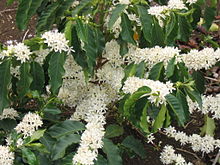Coffee production in Colombia
Colombian Coffee is a Protected designation of origin granted by the European Union (September 2007) that applies to the coffee produced in Colombia[1] The colombian coffee has been recognized worldwide as having high quality and distinctive taste. The main importers of Colombian coffee are United States, Germany, Japan, Holland and Switzerland.
Description

The colombian coffee, also known as Colombian Mild is characterized by its soft terroir. It is produced only with crops of Coffea arabica of several varieties. Among others, Maragogype, Caturra, Typica and Bourbon cultivars are grown. When Colombian coffee is freshly roasted it has a bright acidity, is heavy in body and is intensely aromatic.
History
Coffee was first introduced to the country of Colombia in the early 1800s. The cultive of coffee with trade purposes started since 1835 [2] in Salazar de las Palmas, Norte de Santander and during all the XX century was the main product of exportation in Colombia. In 1999 represented 3,7% of the national income and 37% of the sources of employment. The departments productors of coffee in Colombia are: Norte de Santander, Antioquia, Valle del Cauca, Tolima, Caldas, Risaralda, Quindío and Cundinamarca.
The area represented by the deparments of Caldas, Risaralda and Quindío is known as Colombian Coffee-Growers Axis because this territory concentrates the main amount of high quality cultive crops. In 1999, an earthquake affected severely this region, which expedimented later a fast economic recovery (see 1999 Armenia earthquake).
At the present time, exist in Colombia over one million square miles of coffee crops. Near 75% of the production is exported. The intern market of coffee is regulated by Federación Nacional de Cafeteros de Colombia. Today Colombia accounts for about 12% of the coffee market (by value) in the world, second only to Brazil.
Harvesting process

The peasants pick the coffee berries individually from the plant and pack them in fique sacks, carrying the fruits on their backs, or with help of pack animals to the depulping machine. The pulp is used as compost and the coffee beans are fermented in containers during 24 hours. This fermentation is a key phase in the production of coffee, since it enhances its quality.
After the fermentation, the coffee beans are washed with water to remove dirty, vegetal matter and damaged coffee beans. This cleansing is the feature that separates the Colombian Mild Coffee from other mild non-washed coffees such as the Mild Brazilian. The coffee beans must be dryed under the direct sunlight and covered during the night and when raining.
Roasting

The coffee beans were roasted with charcoal in saucepans since the XIV century. In the late XIX century, the roast in rotatory gas-ignited chambers was developed, and is still in use today. The temperature is set between 400ºF - 425ºF and the time is between 10 to 20 minutes. The effect of the heath in the coffee bean is that the starchs are converted into aromatic oils which gives the coffee its characteristic flavor.

According with the type of roasting, from low roast to high roast, the coffee beans are classified as:
- Level: Cinnamon Roast. Aspect: Slightly roasted, Light cinnamon color. features: Nut flavor, High acidity
- Level: American Roast. Aspect: Mid Roasted, Chestnut color. Features: caramel flavor
- Level: City Roast. Aspect: Mid Roasted, medium brown, no oils on surface. features: Full coffee flavor, mid acidity.
- Level: Full City Roast. Aspect: Mid Roasted, medium-dark brown. Features: Full coffee flavor, low acidity
- Level: Vienna Roast. Aspect: Intense Roast, dark brown, traces of oil on surface. Features: Slightly bitter flavor
- Level: French Roast. Aspect: Intense Roast, dark brown-black, oily surface. features: Bitter flavor
- level: Italian Roast. Aspect: Intense roast, bitter, black, oily surface. Features:Smoked flavor
- Espresso Roast. Aspect: Intense Roast, specific for espresso machines. features: Smoked sweet flavor
Café de Colombia logo
The logo of Juan Valdez and his mule Juan Valdez is the logo of colombian coffee (Café de Colombia).
The Juan Valdez logotype was created by Doyle Dane Bernbach in march, 1981. It includes the fictional character, Juan Valdez, his mule (Conchita) and the colombian mountains in the background. Its purpose is identify the coffee products made with 100% Colombian coffee and approved by the National federation of Coffee-growers.
Coffee research in Colombia
The national center for coffee research (Spanish acronym CENICAFE) develops several lines of research in genetic improvement of varieties of Arabica, and natural resistence against pests such the Colombia Variety (a modified Caturra which is resistant to Roya (Hemileia vastatrix) and programs against the Coffee borer beetle such as the biologic control with Beauveria bassiana fungus.
The Tiwun Coffee
The Tiwun (from the arhuaco language word for "origin") is an organic coffee produced by the arhuaco people of the Sierra Nevada de Santa Marta. The product is part of a program of the Colombian government to fight against the narcothic crops, and to preserve the cultural heritage of environmental friendly agriculture of the indigenous people. The Tiwun is currently expoorted to Japan, USA and Europe.[3]
References
- ^ European Union gives to 'Café de Colombia' the protected denomination of origin, Terra, Published 13/08/2007
- ^ History of coffee and Economy of coffee in Colombia, Coffee Guides
- ^ http://www.cecodes.org.co/boletin2007/cafearhuaco.html
